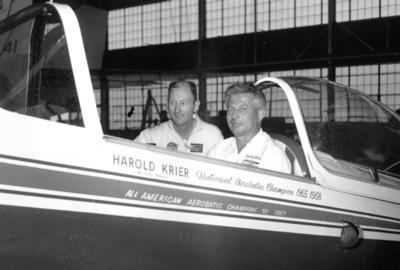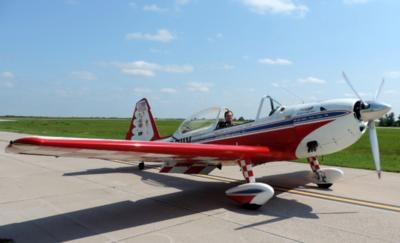Airplane Was At One Time Owned By Harold Krier
The Air Power Museum Inc (APM) proudly announces the addition of a rare and historic DeHavilland Super Chipmunk, once owned by airshow great, Harold Krier, to its collection. Since 1946 several nations have used Chipmunks for training military pilots, but this two-seat aerobatic trainer, N6311V, was designed to be the first monoplane to represent the USA in world aerobatic competition.

Krier had served as a flight engineer on bombers during WWII and afterwards he learned to fly and fell in love with aerobatics. By the mid-1950s Harold was performing in a clipped-wing Cub and later in a modified Great Lakes biplane plus a biplane of his own design, the Krier Kraft. Think of it as a cross between the Great Lakes and a Bucker Jungmeister. With an introduction from his friend and fellow airshow pilot, Frank Price, Harold Krier toured the country in Bill Sweet’s National Airshow, where he remained until his death in a test flight accident in 1971.
The post-war period brought rapid innovation in all aspects of aviation, including aerobatic competition, thanks in part to Antique Airplane Association (AAA) & APM founder, Robert Taylor. Harold Krier claimed top prizes in the AAA Aerobatic Championships in 1958 through 1960, with the trophy retired in his name in 1966, the same year the Chipmunk appeared with the US team in international competition in Moscow.
Harold realized that to compete internationally, he needed a slick monoplane. Enter the Chipmunk…with serious modifications.

Harold clipped and metalized the Chipmunk’s wings, lengthened the ailerons, redesigned the tail, beefed up the airframe and hung a 200-hp Ranger engine on the nose. Thus, the first aerobatic monoplane to represent the USA in international competition was born, and the innovations in Krier’s Super Chipmunk set the standard for most future competition monoplanes. Considering the huge amount of engineering that went into creating the Super Chipmunk, it’s a credit to Krier’s love of aerobatics that he gave away all the modification data to anyone who wanted to copy it. Art Scholl and Skip Volk gladly took up his offer and kept the Super Chipmunk in the game long after Harold’s death at age 49.
Given this airplane’s history, it’s easy to see why APM is so pleased to receive the gift of Harold Krier’s Super Chipmunk from Todd and Jo Peterson (well known aerobatic & airshow pilots in their own right) of El Dorado, KS. The Chipmunk and related artifacts/memorabilia will eventually be displayed, along with Frank Price’s Great Lakes biplane (The first US entrant in the modern world aerobatic contest 1960), which was donated to the APM in 1984 by then Christiansen Industries Pitts test pilot Mel Baron, and is currently on display in the main museum hangar.
These two aircraft along with the APM’s collection of Duane Cole’s personal memorabilia, will form the centerpiece of the future Earl Adkisson hangar at the APM.
A major fundraising effort to both restore the Great Lakes to flying condition, plus build the foundation for and reassemble the Adkisson hangar will be announced in the next couple of weeks.
We feel honored the Peterson’s have chosen the APM to display this historic aircraft, as well as continue to keep Harold Krier’s legacy to the aerobatic/airshow industry alive for future generations.
(Images provided with Air Power Museum news release)
 ANN's Daily Aero-Term (04.28.24): Airport Marking Aids
ANN's Daily Aero-Term (04.28.24): Airport Marking Aids Aero-News: Quote of the Day (04.28.24)
Aero-News: Quote of the Day (04.28.24) ANN's Daily Aero-Linx (04.28.24)
ANN's Daily Aero-Linx (04.28.24) Aero-News: Quote of the Day (04.29.24)
Aero-News: Quote of the Day (04.29.24) ANN's Daily Aero-Linx (04.29.24)
ANN's Daily Aero-Linx (04.29.24)




